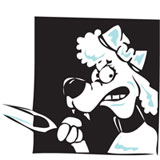Dogs in the Manger and Missile Toes
Share the Road with Santa
SHARE THE ROAD WITH SANTA: It’s become fashionable in some political circles to bemoan the so-called war on Christmas. Should this conflict play out anything like the war on drugs, poverty, cancer, or terror, I’d say Christmas — even when euphemistically referred to as “the holidays” — has clearly won. In Santa Barbara, by contrast, we fought our jihad against Christmas 15 years ago, and, I regret to report, Santa Claus was tarred and feathered, exiled ignominiously to Oxnard, and subsequently strafed by a carload of drive-by shooters, no doubt in the throes of youthful exuberance. I am referring to the 18-foot-high papier-mâché Santa Claus figure that for 52 blissful years loomed large over Santa Claus Lane as one of the most gleeful expressions of unrepentant tac-o-rama and roadside kitsch west of the Mississippi. Santa — along with an equally garish Frosty the Snowman — qualified as genuine landmarks for car-bound families on road trips, alerting them they were passing by Rick and Pat McKeon’s outlandish North Pole amusement park, replete with petting zoos, miniature train rides, and more date shakes than one could stir a straw in. By 2000, Santa Claus Lane found itself in the throes of a Guccification effort, and Jolly St. Nick was impeding the progress of property values. Despite valiant efforts by preservationists — the figure constituted a “vestigial remnant of the American roadside vernacular,” they explained — the Powers-that-Be decreed Santa had to go. It was a commercial road sign, they sniffed, not even architecture. Even King Herod would have been kinder. In 2002, the eviction orders were executed, and Santa Claus was relocated to the digs of a private Oxnard water company where he forlornly watches over the freeway.

I dredge up this ancient history because where Santa Claus is concerned, the Powers-that-Be are intent on adding insult to injury. They are quietly trying to snuff out what’s known as “The Santa Claus Lane bike path” before the plan’s ink has dried. To the extent there’s a villain involved, it’s Caltrans and that agency’s my-way-is-the-highway quest to widen the freeway from Santa Barbara to Carpinteria. Naturally. All roads, after all, lead to Highway 101.
Even by my standards, this may be a stretch. But it’s Christmas, so I’m entitled. To widen the freeway, Caltrans must first widen two Carpinteria bridges that span Highway 101, one by Linden Avenue, the other by Casitas Pass. Naturally, Caltrans wanted to install mondo-gargantuan, industrial-scale bridges, and naturally these mortally offended the Mayberry-style sensibilities of all card-carrying Carpinterians. In a tour de force of bureaucratic evasion, denial, and double-speak, Caltrans managed to ratify an environmental impact report decreeing there were no adverse “impacts” to the project, even though the document detailed how the new-and-improved bridges would inflict serious damage to two nearby creeks and also cannibalize eight acres of farmland. Normally these two non-impacts are deal killers. But because these adverse consequences were not officially designated as “impacts,” Caltrans was not legally required to mitigate anything. In a token concession to reality, however, the report concluded that these nonexistent impacts could and should be addressed at a later date when the Carpinteria City Council makes the necessary changes to the city’s Local Coastal Plan to allow the bridge widening — and freeway widening — to proceed.
When the bridge project got to the Coastal Commission, the Kommissars du Koast concluded that Caltrans should build two new and relatively tiny stretches of Class I bike lanes along the coast, which, combined, would plug major gaps in bike access along the coast. One of these lanes would begin at Santa Claus Lane and run to Carpinteria Avenue in downtown Carpinteria. The other would run from downtown Carpinteria to Rincon Point. These two new lanes would connect the dots to form a new bikeway spanning about five miles; it would also provide cyclists and pedestrians infinitely safer and vastly more scenic routes than they have now. By connecting with coastal bike routes that already exist, they’d also allow cyclists to ride all the way from UCSB to Mussel Shoals. In other words, it’s a very big deal.
In fact, the Kommissars thought these bike lanes were such a big hairy deal that they decreed the lanes had to be built before the bridge-widening project could even commence. The bike lanes, they admitted, are not cheap. But lack of funding, they insisted in fine print inserted into their ruling, would not constitute an acceptable excuse for Caltrans to renege on the deal. Guess what? Caltrans is already reneging.
Last month, the Carpinteria City Council convened to ratify the Local Coastal Plan changes needed for the bike lanes to be built, the bridge expansions to take place, and eventually for the freeway widening to occur. At that meeting, representatives from Caltrans made it clear they regarded the bike lanes as the City of Carpinteria’s “pet project.” It was decidedly not, they insisted, part of their own project. And because of this, the Caltrans reps made clear, they were not financially obligated in any way, shape, or form where the bike lanes were concerned. What they didn’t say is, “Hope you got kissed because you sure got screwed.” They didn’t have to.
Caltrans has problems of its own. The freeway-widening project is slated to cost $450 million. Santa Barbara voters authorized bonds in 2008 — in the form of Measure A — to the tune of $140 million. Other transportation taxes that normally go to area road-improvement projects were cannibalized to the tune of $135 million. That means Caltrans is roughly $200 million in the hole where funding for the freeway widening is concerned. I sympathize. I even empathize.
But asking Carpinteria to pony up the funds to mitigate the negative environmental impacts created by Caltrans is kind of like expecting someone to pay out of pocket for all the wonderful Christmas presents they get. Bah, humbug! But Merry Christmas.



